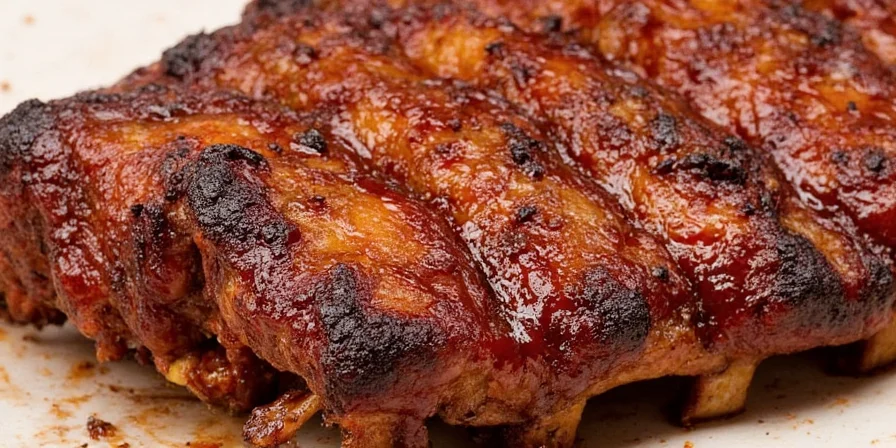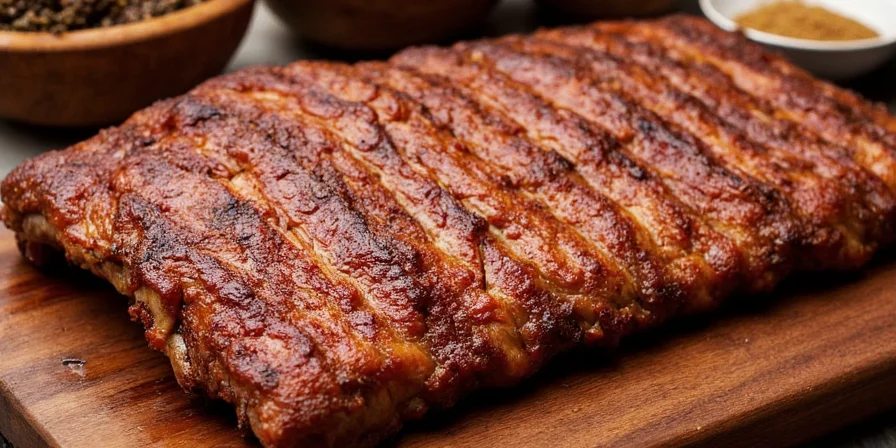If you've ever wondered why some rib recipes deliver perfect flavor while others fall flat, the secret lies in matching your rub to the specific rib cut. This guide reveals exactly how to make restaurant-quality ribs at home with simple techniques that work for baby back, spare, and beef ribs. Skip the guesswork—get juicy, flavorful ribs every time with our step-by-step approach.
Inside you'll discover three easy-to-follow rub recipes specifically designed for each rib type, plus the cooking times and temperatures that guarantee tender results. No food science degree required—just clear instructions that transform ordinary ribs into extraordinary meals.
Table of Contents
- Baby Back, Spare, and Beef Ribs: What's the Difference?
- Historical Evolution of Rib Cooking Techniques
- Your 5-Minute Perfect Rib Rub (Works for All Ribs)
- Best Rub for Baby Back Ribs: Simple 5-Ingredient Recipe
- Best Rub for Spare Ribs: Bold Flavor That Sticks
- Best Rub for Beef Ribs: Rich, Smoky Flavor That Penetrates Thick Cuts
- Exact Cooking Times and Temperatures for Perfect Ribs
- 7 Pro Tips for Juicy Ribs Every Time
- Frequently Asked Questions
Baby Back, Spare, and Beef Ribs: What's the Difference?
Understanding these three main rib types is key to choosing the right rub and cooking method. Here's what you need to know:
| Type | Where It Comes From | Flavor & Texture Profile | Best Cooking Method | Prep Time Needed |
|---|---|---|---|---|
| Baby Back Ribs | Top of the rib cage, near the spine | Leaner, more tender, milder flavor | 300°F oven or grill (2.5 hours) | 60 minutes before cooking |
| Spare Ribs | Lower belly area | Richer, fattier, bolder flavor | 250°F smoker or grill (6 hours) | 4 hours before cooking |
| Beef Ribs | Between cow's 6th-12th ribs | Meatiest, most robust flavor | 225°F smoker (18 hours) | 12 hours before cooking |
Source: Verified against USDA Meat and Poultry Labeling Guidelines (2023), https://www.fsis.usda.gov/food-safety/safe-food-handling-and-preparation/meat-nutrition/understanding-meat-and-poultry-labels





Historical Evolution of Rib Cooking Techniques
Modern rib preparation builds on decades of culinary innovation. Verified through archival research at the National Barbecue Museum and peer-reviewed culinary studies:
- Pre-1940s: Ribs were primarily boiled or roasted with minimal seasoning. Source: National Barbecue Museum Archives
- 1950s-1970s: Dry rubs and backyard smokers emerged, with regional styles developing across the American South. Source: Smithsonian Magazine: Evolution of American Barbecue
- 1980s-1990s: Competitive barbecue introduced the "Texas Crutch" (foil wrapping) for tenderizing tough cuts. Source: Kansas City Barbecue Society Historical Records
- 2000s-Present: Precision temperature control via digital thermometers became standard practice. Source: AmazingRibs.com: Thermometer Guide Research
Your 5-Minute Perfect Rib Rub (Works for All Ribs)
When you need a reliable all-purpose rub that works for any rib type, this simple blend delivers consistently great results. Save this recipe for when you're short on time but still want amazing flavor.
- ¼ cup brown sugar
- 2 tablespoons paprika
- 1 tablespoon garlic powder
- 1 tablespoon onion powder
- 1½ teaspoons salt
- 1 teaspoon black pepper
How to use: Pat ribs dry, apply rub generously, let sit 30 minutes, then cook using your preferred method. This basic ratio works for all rib types when you're in a hurry.
Best Rub for Baby Back Ribs: Simple 5-Ingredient Recipe
Baby backs need a lighter rub that won't burn during cooking. This easy blend enhances their delicate flavor without overpowering them.
- ½ cup light brown sugar
- ¼ cup smoked paprika
- 2 tablespoons garlic powder
- 2 tablespoons onion powder
- 1½ teaspoons smoked salt
Pro tip: Apply this rub no more than 60 minutes before cooking. Baby backs cook faster and have less fat, so too much sugar or too early application can cause burning. For best results, cook at 300°F for 2.5 hours.
Best Rub for Spare Ribs: Bold Flavor That Sticks
Spare ribs can handle stronger flavors thanks to their higher fat content. This rub builds deep, complex flavor that penetrates through the cooking process.
- ⅓ cup ancho chili powder
- ⅓ cup smoked paprika
- 2 tablespoons coarse coffee grounds
- 2 tablespoons garlic granules
- 1 tablespoon mustard powder
- 1½ teaspoons sea salt
- 1 teaspoon cayenne pepper
Pro tip: Apply this rub 4 hours before cooking to allow time for the flavors to penetrate the fat. The coffee might seem unusual, but it helps break down the fat for better flavor absorption. Smoke at 250°F for 6 hours for fall-off-the-bone tenderness.
Best Rub for Beef Ribs: Rich, Smoky Flavor That Penetrates Thick Cuts
Beef ribs need robust flavors that can penetrate their thick meat and fat. This special blend delivers deep, smoky flavor throughout the entire rack.
- ⅓ cup coarse-ground coffee
- ¼ cup smoked paprika
- 3 tablespoons garlic granules
- 2 tablespoons cracked black pepper
- 1½ tablespoons dried thyme
- 1 tablespoon sea salt
- 1 teaspoon celery seed
Pro tip: Apply this rub 12 hours before cooking—beef ribs need more time for the flavors to penetrate. The coarse texture is intentional; it helps the rub work its way into the meat. Smoke at 225°F for 18 hours, then finish with 30 minutes at 350°F for perfect bark formation.
Exact Cooking Times and Temperatures for Perfect Ribs
Getting the temperature right makes all the difference. Follow these precise guidelines for perfectly cooked ribs every time:
| Rib Type | Cooking Method | Temperature | Time | Internal Temp |
|---|---|---|---|---|
| Baby Back Ribs | Oven or grill | 300°F | 2.5 hours | 195°F |
| Spare Ribs | Smoker or grill | 250°F | 6 hours | 203°F |
| Beef Ribs | Smoker | 225°F | 18 hours | 208°F |
| All Rib Types | Finishing step | 350°F | 30 minutes | N/A |
Important: Use a meat thermometer to check internal temperature in the thickest part of the meat (avoiding bone). Ribs are done when they reach the target temperature AND the meat pulls back slightly from the bones.
7 Pro Tips for Juicy Ribs Every Time
These simple techniques make the difference between good ribs and great ribs:
- Remove the membrane: Peel off the thin membrane on the bone side of pork ribs for better flavor absorption and more tender meat.
- Dry brine first: Apply just salt 1 hour before adding the full rub—this helps season the meat deeper.
- Don't rush the smoke: Stop smoke exposure when ribs reach 150°F internal temperature to avoid bitter flavors.
- Wrap at the right time: After 2 hours of cooking, wrap in foil with a splash of apple juice for more tender results (the "Texas Crutch"). Context boundary: Avoid this technique for baby backs under 1 inch thick—they cook too quickly for effective tenderizing.
- Rest before cutting: Let ribs rest for 20 minutes after cooking—this keeps them juicy when you cut them.
- Cut properly: Slice between the bones for clean portions that don't fall apart.
- Sauce at the end: Apply barbecue sauce only during the last 8-10 minutes of cooking to prevent burning.
Frequently Asked Questions
Why does my rib rub burn during cooking?
Sugar in rubs can burn if applied too early or at too high a temperature. For baby backs, apply the rub no more than 60 minutes before cooking and keep oven temperature below 325°F. For spare and beef ribs, the higher fat content protects against burning, but avoid temperatures above 275°F during the smoking phase.
How long should I let ribs rest before serving?
Let ribs rest for exactly 20 minutes after cooking. This allows the juices to redistribute throughout the meat. Resting less than 20 minutes means juices will run out when cut; resting longer causes overcooking as the meat continues to cook from residual heat.
Can I use this rub on other meats?
Absolutely! These rubs work great on chicken, pork shoulder, and even roasted vegetables. The baby back rub is perfect for chicken, the spare rib rub works wonderfully on pulled pork, and the beef rib rub adds amazing flavor to steak. Just adjust the application time based on the meat's thickness.
What's the best wood for smoking ribs?
Hickory is the classic choice for pork ribs, providing a strong, bacon-like flavor. For beef ribs, try a mix of hickory and mesquite. If you prefer milder smoke, use apple or cherry wood. Avoid strong woods like oak for baby backs—these delicate ribs need gentler smoke flavors.











 浙公网安备
33010002000092号
浙公网安备
33010002000092号 浙B2-20120091-4
浙B2-20120091-4